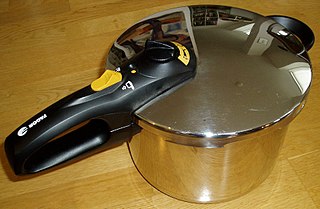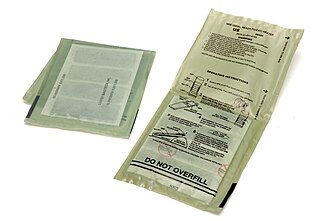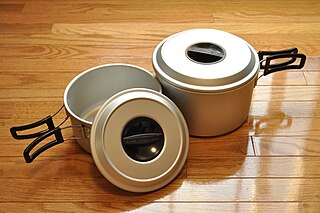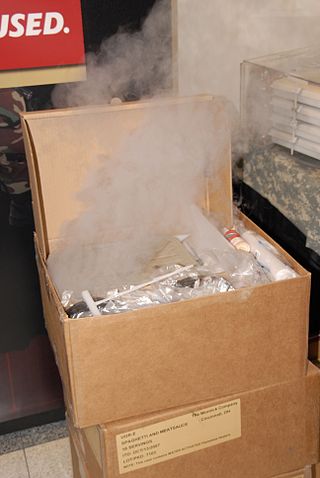
A food warmer is typically a table-top device used to maintain the serving temperature of prepared food. It is used both in homes and restaurants.

A food warmer is typically a table-top device used to maintain the serving temperature of prepared food. It is used both in homes and restaurants.
When used domestically, such as with fondue, a food warmer may simply be a small vessel containing food upon a trivet which contains a heat source such as a flame or electric element.
Some food cookers can then, in essence, become food warmers as they use a reduced heat to maintain a serving temperature. [1] Electric rice cookers do this automatically. A multicooker is an electric kitchen appliance for automated cooking using a timer. In addition to cooking programs, a multicooker may have functions to keep food warm. [1]
Some electric-powered personal-sized food coolers have a setting that serves to warm food inside of the cooler. [2] These are typically marketed as cooler/warmers. [2]

Commercial food warmers are used in restaurants as well as outdoor food carts.
In restaurants and hotels they may operate the same way, but on a larger scale. Buffets commonly use large, stainless steel containers with a sterno fuel source. Restaurants also use steam tables to keep multiple vessels warm at once. These have a large, shallow body of water that is kept at a certain temperature with pans of food placed on top, typically rectangle stainless steel. [3] East Asia in particular uses steam tables in restaurants, and notably, portable ones to keep bamboo steamers containing dim sum dishes hot.
A flameless ration heater is a flameless chemical heater used to heat some types of Meal, Ready-to-Eat entrees.
This is a list of food warmers. Some may also serve as cookers.

A bain-marie, also known as a water bath or double boiler, a type of heated bath, is a piece of equipment used in science, industry, and cooking to heat materials gently or to keep materials warm over a period of time. A bain-marie is also used to melt ingredients for cooking.

A wok is a deep round-bottomed cooking pan of Chinese origin. It is believed to be derived from the South Asian karahi. It is common in Greater China, and similar pans are found in parts of East, South and Southeast Asia, as well as being popular in other parts of the world.

A kitchen is a room or part of a room used for cooking and food preparation in a dwelling or in a commercial establishment. A modern middle-class residential kitchen is typically equipped with a stove, a sink with hot and cold running water, a refrigerator, and worktops and kitchen cabinets arranged according to a modular design. Many households have a microwave oven, a dishwasher, and other electric appliances. The main functions of a kitchen are to store, prepare and cook food. The room or area may also be used for dining, entertaining and laundry. The design and construction of kitchens is a huge market all over the world.

Pressure cooking is the process of cooking food under high pressure steam and water or a water-based cooking liquid, in a sealed vessel known as a pressure cooker. High pressure limits boiling and creates higher cooking temperatures which cook food far more quickly than at normal pressure.

A flameless ration heater (FRH), colloquially an MRE heater, is a form of self-heating food packaging included in U.S. military Meal, Ready-to-Eat (MRE) rations since 1993.

A slow cooker, also known as a crock-pot, is a countertop electrical cooking appliance used to simmer at a lower temperature than other cooking methods, such as baking, boiling, and frying. This facilitates unattended cooking for many hours of dishes that would otherwise be boiled: pot roast, soups, stews and other dishes.

A deep fryer is a kitchen appliance used for deep frying. Deep frying is a method of cooking by submerging food into oil at high heat, typically between temperatures of 350 to 375 °F.

Induction cooking is performed using direct electrical induction heating of cooking vessels, rather than relying on indirect radiation, convection, or thermal conduction. Induction cooking allows high power and very rapid increases in temperature to be achieved: changes in heat settings are instantaneous.

A solar cooker is a device which uses the energy of direct sunlight to heat, cook or pasteurize drink and other food materials. Many solar cookers currently in use are relatively inexpensive, low-tech devices, although some are as powerful or as expensive as traditional stoves, and advanced, large scale solar cookers can cook for hundreds of people. Because they use no fuel and cost nothing to operate, many nonprofit organizations are promoting their use worldwide in order to help reduce fuel costs and air pollution, and to help slow down deforestation and desertification.

Sous vide, also known as low-temperature, long-time (LTLT) cooking, is a method of cooking invented by the French chef Georges Pralus in 1974, in which food is placed in a plastic pouch or a glass jar and cooked in a water bath for longer than usual cooking times at a precisely regulated temperature.

A chafing dish is a metal cooking or serving pan on a stand with an alcohol burner holding chafing fuel below it. It is used for cooking at table, notably in Gueridon service, or as a food warmer for keeping dishes at a buffet warm.

A field ration is a type of prepackaged military ration designed to be easily and quickly prepared and consumed in the field, in combat, at the front line, or where eating facilities are otherwise unavailable. Field rations are primarily used by military forces, though they are also sometimes distributed to civilians as part of humanitarian aid and emergency management. They differ from garrison rations and field kitchen provisions, which are intended for where proper meals can be supplied and prepared with relative ease and safety, such as in the rear where logistics are steady and fresh food can be supplied. They are similar to, but distinct from, other purpose-designed long-lasting types of food or rations such as emergency rations, humanitarian daily rations, and camping food.

The Individual Meal Pack or IMP is one type of field ration used by the Canadian Forces. The IMP is designed so that a continuous diet provides all the nutrition needed to sustain a service-person in the field. The IMP meets Canada's nutrition requirements, with the exception of calcium and folic acid, which are not significant if the consumption period of rations is less than 30 (consecutive) days. IMPs provide 1,200–1,400 calories (5.0–5.9 MJ) per meal.

Cooker may refer to several types of cooking appliances and devices used for cooking foods.

Self-heating food packaging is active packaging with the ability to heat food contents without external heat sources or power, usually using an exothermic chemical reaction. Packets can also be self-cooling. These packages are useful for military operations, during natural disasters, or whenever conventional cooking is not available. They are often used for military field rations, camping food, instant food, or other types of food intended for preparation where proper cooking facilities or methods are unavailable or less ideal.

Camping food is food brought on or designed for camping, hiking, and backpacking trips. The term also encompasses ingredients that can be used to make said foods. The primary differences relate to campers' and backpackers' special needs for foods that have appropriate cooking time, perishability, weight, and nutritional content. To address these needs, camping food is often made up of freeze-dried, dehydrated, pre-cooked, pre-prepared, or otherwise preserved foods that can last extended periods.

A multicooker is an electric kitchen appliance for automated cooking using a timer. A typical multicooker is able to boil, simmer, bake, fry, deep fry, grill roast, stew, steam and brown food.

Instant Pot is a brand of multicookers manufactured by Instant Brands. The multicookers are electronically controlled, combined pressure cookers and slow cookers. The original cookers were marketed as 6-in-1 appliances designed to consolidate the cooking and preparing of food to one device. The brand later expanded to include non-pressure slow cookers which can be left on for 8 hours or more, sous-vide immersion circulators, blenders, air fryers and rice cookers.